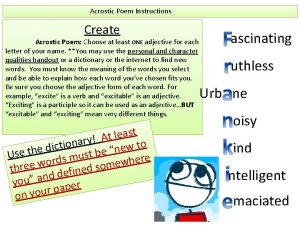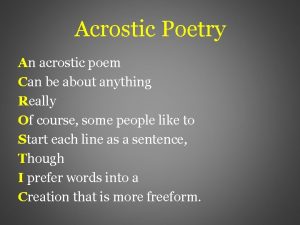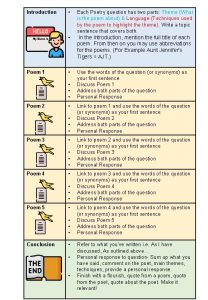How to Write an Acrostic Poem YES YOU










- Slides: 10

How to Write an Acrostic Poem YES, YOU TOO CAN WRITE POETRY

How to Write an Acrostic Poem Tips Chose a subject. Brainstorm for material that relates to the subject. Write the title vertically on the page, one letter per line. Make sure each line starts with the corresponding letter. Every line must relate back to the subject.

Introduction While the origins of the acrostic poem aren't known, there is some rumor that ancient cults once used this form of poetry to identify each other. There is evidence of the ancient Greeks entertaining themselves with acrostic poetry, and many Latin poets also toyed with the form. It was a favorite form among the monks of the Middle Ages as well. It has managed to withstand the test of time as a favored poetic endeavor, and today, many school teachers use the acrostic form to introduce their students to writing poetry. Fun and simple, the acrostic is one of the easiest forms of structured poetry to learn because it only follows two rules.

Rule 1: The Subject Just as it is with all poetry, the subject of the acrostic poem is the most important part. In acrostic poetry, it's even more special because it uses the letters of the subject word to form the body of the poem. You can write about anything in the world; you simply take the name of that thing and turn it into a poem using the letters of that thing. Let’s start out with a name. For example, let's take the name Devon and turn it into a simple acrostic poem: Dramatic Energetic Vivacious Outgoing Nice

This is the simplest form because you only use one word for each letter of the subject. You can go much further than that by adding full lines. Dramatic girl Energetic queen Vivacious dreamer Outgoing, never mean Nice to know!

Rule 2: The Description As you may have noticed in the above example, each line is a description about the subject word. It's one of the reasons they are so much fun for students to write, because they are easy, and students get to write about themselves or a friend. While this may not seem very challenging at first, bear in mind that great poets like Geoffrey Chaucer, Boccaccio, and Edgar Allan Poe were all fond of the acrostic form and took it to the next level of exploration. Let's take a look at one of Edgar Allan Poe's famous acrostic poems titled

Rule 2: The Description "Elizabeth" Elizabeth it is in vain you say "Love not" — thou sayest it in so sweet a way: In vain those words from thee or L. E. L. Zantippe's talents had enforced so well: Ah! if that language from thy heart arise, Breathe it less gently forth — and veil thine eyes. Endymion, recollect, when Luna tried To cure his love — was cured of all beside— His folly — pride — and passion — for he died. Poe not only explored the name Elizabeth in the above acrostic poem, he dove into an emotional entanglement with Elizabeth herself that rivaled that of the Gods. Now that's deep!

Writing an Acrostic Poem So now that you know the basic components, you're ready to start writing your Acrostic Poem. Listed below are a few tips to help you get started: Choose the title, which is also your subject. Brainstorm to come up with words or phrases that remind you of your subject. Write the title vertically along the left edge of the paper. As you being writing, be sure that each line begins with the letter that corresponds to the title. Make sure every line relates to the line before, but more importantly that it relates back to the subject.

Writing an Acrostic Poem Once you get the hang of the acrostic poem, branch out into more difficult phrases and create longer and more descriptive lines the way Poe did in the example provided in Step Two. As you master the acrostic you can have a lot of fun with it, creating double acrostics, which have two subject words: one in the front and one at the end.

Now try writing an Acrostic Poem using your name or that of a friend.



















